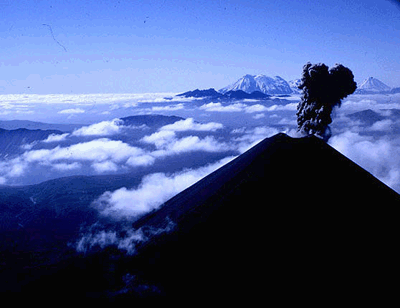Some volcanoes explode in one violent outburst, but the regular eruptions of an active 'Strombolian' volcano are interrupted by 'chugging' - that is, frequent small eruptions. Jonathan Lees of the University of North Carolina, US, and colleagues believe that this characteristic pattern is due to the viscoelastic properties of lava, and they have developed a model that accurately predicts the behaviour of these periodically exploding volcanoes. Lees and colleagues based their model on studies of Karymsky, a Strombolian-type volcano in eastern Russia that has active periods that last about 12 years separated by similar periods of calm.

The cool, thick lava near the top of the volcano is almost solid, and fills just the top 100 metres of the central cylindrical channel. In effect, this cold lava ‘corks’ the volcano. The hot magma deeper in the channel is under much greater pressure, and this column of low-viscosity lava is about 5 kilometres deep. Lees’ team assumes that the channel of Karymsky is fed at a constant rate from the magma chamber below.
Large quantities of gas are dissolved in the magma deep inside the volcano and this makes it very compressible. As magma flows upwards, it compresses the hot lava already in the channel, and pressure builds up beneath the cold lava plug. This build-up period is the dormant phase of the volcano. When the pressure reaches a certain level, the upward shear forces acting on the plug make the cold lava around its rim much less viscous. This is because semi-viscous lava becomes ‘runnier’ than highly viscous lava when shear stress is applied to it. Once the rim of the plug has melted, the pressurised lava lifts the plug and the volcano belches gas and ash.
Once some of the pressure is released in this way, the plug sinks back into the volcano. The shear stress around the rim of the plug falls temporarily, and the plug again adheres to the column. But this phase is short-lived because as the plug falls, it compresses the lava, storing elastic energy. The lava pushes upwards again, exceeding the shear stress needed to melt the rim of the plug. This ‘chugging’ process then repeats itself. The time it takes for the pressure to build up to this level leads to the characteristic ‘phase’ of the volcano.
The model devised by Lees and colleagues – which accounts for the density, temperature, viscoelasticity and pressure of the lava – describes both the fast- and the short-period patterns of emission from Karymsky. “We are optimistic that it will fit accurately the behaviour of other Strombolian-type volcanoes”, Lees told PhysicsWeb. “These include Sangay in Ecuador, Arenal in Costa Rica, and Semeru in Indonesia”.



